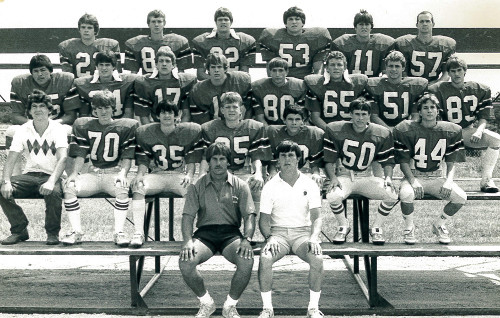Morrison was Record-setting Oklahoma Eight-player Football Program
By John Gillis on September 22, 2015 blog Print
The 14-0 1984 state championship Morrison High School football team, with Joe Sindelar seated front left, and Dennis Casey, seated front right
With an enrollment of just 130 students, Morrison (Oklahoma) High School might be small in numbers, but it definitely stands tall when it comes to its storied eight-player football program.
Located in Morrison, Oklahoma (population 793) – 80 miles north and slightly east of Oklahoma City – the Wildcats gridiron program enjoyed tremendous success during its halcyon days of the 1980s, 1990s and 2000s.
Altogether, Morrison has won 14 Oklahoma Secondary School Activities Association (OSSAA) state football championships - 13 in eight-player (1984, 1986, 1988, 1989, 1990, 1991, 1992, 1993, 1994, 2003, 2005, 2006 and 2007) and one in Class A 11-player (2008).
According to the NFHS’ National High School Sports Record Book, the 13 titles represents the national eight-player record, comfortably ahead of St. David (Arizona) High School and Midway-Denton (Kansas) High School with eight state titles each.
The Wildcats’ seven consecutive eight-player state titles from 1988 to 1994 is the national record in that particular category – one ahead of Falls City (Nebraska) Sacred Heart High School and Shattuck (Oklahoma) High School with six each.
Morrison also holds the eight-player national record for undefeated seasons with nine from 1989 to 2007, as well as consecutive undefeated seasons – in which it is tied with Falls City (Nebraska) Sacred Heart High School with six consecutive unblemished campaigns.
In addition, the Wildcats won 90 consecutive games from 1988 to 1995 – which according to the Record Book was at the time the eight-player national record. It currently ranks second behind another Oklahoma high school – Shattuck High School – which won 93 in a row from 2003 to 2009.
When compared to the other versions of high school football, Shattuck and Morrison trail only 11-player programs Concord (California) De La Salle High School with 151 consecutive victories from 1992 to 2003 and Charlotte (North Carolina) Independence High School with 109 in a row from 2000 to 2007. After Morrison, Batesville (Mississippi) High School (also 11-player) rounds out the top five with an 89-game winning streak from 2003 to 2008.
Engineering Morrison’s great success were two savvy and skilled head coaches – Dennis Casey, who led the program to OSSAA state titles in 1984, 1986, 1988, 1989, 1990, 1991 and 1992, and Joe Sindelar, who paced the Wildcats to championships in 1993, 1994 and 2003. Interestingly, current Morrison High School head football coach and athletic director Cory Bales was Casey’s manager in fourth grade.
As a 21-year-old in 1982, Casey landed a job as a history and government teacher and head football coach at Morrison High School. At that time, the Wildcats program had not enjoyed great success. During his tenure at Morrison from 1982 to 1992, Casey led the program to seven OSSAA eight-player state championships, one runner-up finish, eight area titles and 10 regional titles – as well as to a glittering 130-15 win-loss record.

Coach Dennis Casey coaching his 1982 (first season) Morrison High School football team
Casey then coached at Cushing (Oklahoma) High School and at Claremore (Oklahoma) High School. He left the coaching profession with a career win-loss record of 184-38.
In a career change, Casey worked for the Oklahoma Department of Career and Technology Education and then entered secondary education administration as Morrison’s superintendent. The Republican Casey was elected to the Oklahoma State Legislature in 2010, where he represents House District 35 and is a member of three committees. He notes certain similarities between coaching and government service.
“It is always fun and rewarding helping people,” Casey said. “Coaching and being a representative are somewhat similar. It’s probably not as democratic in your decision-making, but it’s still about pulling people together for the common good. It is about the team and not individuals. I look forward to the day to be back coaching.”
In the truest unselfish mentoring fashion, perhaps his greatest accomplishment was not his personal coaching success, but rather how he passed his abilities and philosophies on to his players who in turn enjoyed great coaching success of their own.
“You know, one thing I am most proud of is the former players from Morrison who have gone into the coaching profession and have led their schools to state titles and runner-up finishes,” Casey began. “Among those players are Bret Brown, Tony Hawkins, John Kerr, David Kerr, Cory Bales and Lynn Shackleford. They all have had a combination of one to three state titles or runner-up finishes.”

David Kerr (No. 10) was a Morrison quarterback who went on to guide high school football teams to several state titles and runner-up finishes
As far as the “secrets of success” of the Morrison program, Casey points to a variety of factors.
“Well, a couple of things contributed to our success,” Casey said. “Staying healthy was a big key. In small schools, one thing that helps is to not have back-to-back classes with limited abilities or low numbers of boys. We were always fortunate to have that situation except for 1985 when we started five freshmen. Morrison is a great community, and there are high expectations and an excellent work ethic. I give the community a lot of credit and praise.
“When I started, I was young, I was very demanding, and the community allowed me to grow and make mistakes. We did have excellent participation with the kids. The faculty at the school all share in the pride of our students. We were academic state champs several times. I can assure you no one person was the reason - it was truly a community project from the kids to the parents and the faculty.
“I just loved dealing with the kids and helping them become productive adults. On Friday nights - no matter the size of the community - it is as important to that community and to those kids as any Super Bowl game. I love small school football.”
When Casey was head coach, his defensive coordinator was Sindelar. While neither was initially highly versed in eight-player football, they quickly became a formidable coaching tandem.
“In the beginning, neither of us was familiar with the eight-man game,” Sindelar recalled. “Dennis coordinated the offense, and I coordinated the defense. We became instant friends and worked very well together and were philosophically matched. Dennis has a very creative offensive mind and we are both VERY competitive people. He would throw some wrinkle into his offense, and I would try to counterpunch in practice with alignments, blitzes, coverages, etc. Of course, Dennis would respond with a new wrinkle, or something innovative and both of us grew as coaches through this competitive nature. When Dennis left in 1993, I was hired as the head coach. Cory Bales played for us and when he graduated from college, Cory came to be my assistant coach.
“In addition to winning the three state titles, we also had several runner-up and semifinal teams and even two quarterfinal teams. However, what I am most proud of is the consistency that was developed during my time as a head coach. We were in the playoffs every year, and we were in the semifinals or finals every year except two.”

Former Morrison quarterback Cory Bales (No. 1 carrying the football) is now Morrison’s head football coach and athletic director
When Sindelar took the Morrison reins, the Wildcats were riding a 51-game winning streak. That skein finally ended at 90 games on November 25, 1995 when the top-ranked Wildcats fell to sixth-ranked Snyder (Oklahoma) High School, 40-36, in an OSSAA eight-player semifinal contest played in Mustang, Oklahoma.
With Snyder leading, 40-34, Morrison drove to the Snyder eight-yard-line, but came up short on a fourth-and-one with a minute to go in the game. Snyder took over and took a deliberate safety with nine seconds left to make the final score, 40-36.
“That was a scoring fest that I am sure was a great game for spectators, but gut-wrenching for coaches,” Sindelar began. “We were behind by six and drove deep into their territory and on a fourth and just a very little. We went for it and never made it. It was crushing, and I remember people saying things like ‘We will just start another streak.’ At that time and even now, I thought ‘You don’t understand what you have just witnessed.’ I know they meant well. I have a tremendous respect for what those players accomplished knowing full well that we would never experience anything like that again.
“Winning was a huge source of pride for the community. I believe Morrison football really did bring about a lot of notoriety for the community, and the winning streak brought about national attention. I am still amazed at how many people from all walks of life know about Morrison football - the block ‘M’ on the helmets, and how it means something to the players and the community. It has a special meaning to all of us who are a part of that heritage. A person cannot understand the bonding agent of a national winning streak program unless they have lived it – and there are not many communities that have done that.”
John Gillis
John Gillis is the associate director of development of the NFHS. If you have any comments or articles ideas, please forward them to Gillis at jgillis@nfhs.org
Most Recent Articles
- nfhs news NFHS Learning Center Unveils School Honor Roll Program
- NFHS Network Contact Information
- nfhs news Shout-out to Health-Care Workers and State High School Associations
- state news Stadiums Across Colorado Light Up to Show Support for Students
- gymnastics-girls article ‘They became a family’: How New Castle gymnastics qualified for state for first time since 2002



